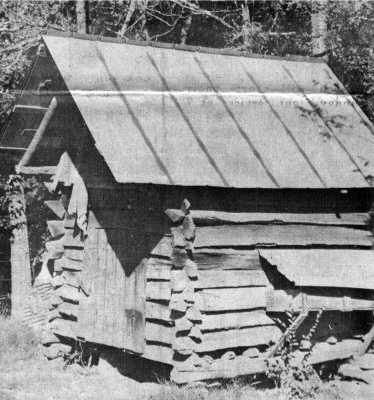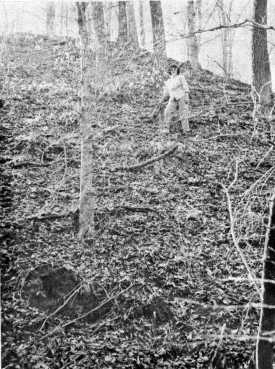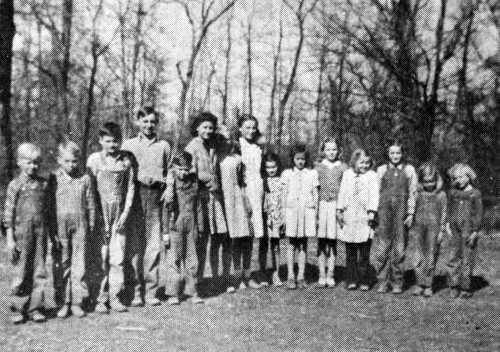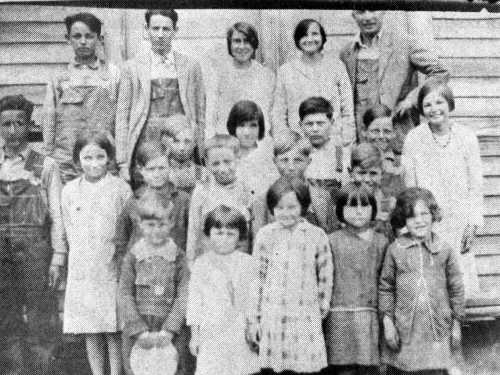A LOOK BACK TO SMITH SCHOOL DAYS
Brenda Kirk Fiddler
Lexington Progress, April 8, 1992
Not so many years ago, each community in Henderson County had its own school. Smith School was in the extreme northwest tip of District 1, less than a half-mile from the Carroll County line. The remote location and dirt roads kept the area generally isolated until 1950. Life remained virtually unspoiled for the residents, most of whom were kin and could trace their ancestry back to the Smith, Spain, Blackwell, James and Stanford families who settled there by 1840.
Spain and James Cemeteries record the presence of the early families. There is also a record of a Spain Post Office in 1860. Near the Zannie Gateley house once lived the family of David Spain, including 13 sons. All of the boys weighed 200 pounds plus and "anyone of them could hoist a barrel of whiskey and drink from it." Perhaps one of these boys is responsible for the origin of the Spain cemetery. It has been told that a Spain man was cursing the heavy rain as he took shelter under a large rock. The rock caved in on him and he became the first person to be buried there.

The Louis James Wagon Shop
Louis James, who settled here before 1830, is buried in the James Cemetery. He and his brother stopped off while traveling west to seek a new home. Louis, impressed with the plentiful springs, staked claim to 700 acres. His brother moved on. Louis was a wagon maker and his shop still stands near the house built by his son. It is now occupied by a direct descendant and the James kin still talk about the time when Jessie James from Missouri was passing through and spent the night in this house with his cousins.
Archie Smith, known as the "granddaddy of all the Smiths," may have owned, the land that the building which served as church house and school house was built. At least four buildings were used. The first-known teacher was Miss Margaret Hamilton. Baptist preachers holding meetings there were Bros. Nunnery, Pollard, Davis and Page.
In 1904, John Kirk made this entry in his journal: "August 27-worked on fence by creek. Went to meeting at Smith Schoolhouse." In early September, he wrote, "meeting broke and 30 baptized."
Until 1935, the students had no desks and sat in the pews. Jim James, a student in the 1920s, loved hearing the teacher tell the children to close their books and make room for their parents to come in for preaching.
One of the most memorable teachers was Mr. Harvey Clark, a Methodist preacher. When he gave instructions in his deep bass voice, everyone listened. He commuted by home, mule or buggy. He loved traveling and Leland Stanford recalls Mr. Clark stopping by his house early in the morning and declaring, "This mule is going to drink from the Tennessee River by night."
In the winter of 1931, Mr. Clark taught a night school at nearby Moss Rest. The two-month term was designed to instruct older students who had gotten behind in their studies. Because of students having to miss school to help with chores or being unable to get there (the creek would rise above the footlogs), much of a five-month school term could be missed. Raymond Blackwell says that Mr. Clark taught him more in that two months than he had learned in all of his other schooling put together. Travel was also difficult for the teachers. Once, it was so muddy that Mr. George Johnson, a teacher from Scotts Hill, had to borrow a horse from Leland Stanford's father to ride home for the weekend. Mr. Stanford, who received an eighth-grade diploma from Smith, walked two miles to New Bethel School in Carroll County to finish out terms for two teachers who could not get in to teach. (It was just as muddy across the line).
The quick action of Mr. Johnson and his students saved the building from burning in 1932. A little boy, who had gone out "to be excused," came running back in, crying excitedly, "Teacher, teacher, the school's on fire!" Luckily, the water bucket was full and Mr. Johnson climbed upon a pew and doused the flames. In 1934, the school was destroyed by fire. A room in the home of Brodie Stanford was used for the few weeks that it took to build the new school, a small structure with a front porch.
Mrs. Seabbie Berryman's 27 years of teaching included two terms at Smith, 1936-37 and 1940-41. At first, she walked the 17 miles to school and back from her home at Poplar Corners. Her monthly salary was $60, paid in warrants which were discounted as much as 50 percent. The depression made money scarce, even for the Board of Education. Cotton pickers had to pick 100 pounds to earn 50 cents; cotton choppers worked all day for 50 cents.
Mrs. Berryman also rode a mule. Old Billy was reliable except that he hated cars and just the sound of one would make him veer completely off into the woods until the road was clear. About cars, old Billy was stubborn as a mule. Then Mrs. Berryman began driving her Model A, purchased for $20 from Nelson James. One day she became mired in the mud. The man passing by "helped" by have her push while he steered.
In 1941, a young lady by the name of Miss Virginia Scott received her first teaching assignment. Since she was not familiar with the Smith community, she decided to go a few days early to prepare for the opening day in early July. Carefully following her instructions as to whose house to pick up the school key, she found the man sitting in a chair, leaning against a tree, barefoot, overalls rolled up and smoking his pipe. She introduced herself and her reason for being there. He ignored her. Thinking that he was slightly deaf, she loudly repeated that she was the new teacher and needed the key. He gave her a good looking-over and said, "You ain't growed, are you?"
Mrs. Virginia Scott Houston, now retired from Caywood, remembers her year at Smith as being one of her most enjoyable. The 16 students were cooperative and the parents supportive. She boarded first with Preacher Hersey Hopper and his wife Beatrice, and then with Bob and Gracie Stanford. On her daily mile walk to school, she was accompanied by many of her students. As soon as they arrived, they would raise the flag and have the pledge of allegiance outside.

Brenda Fiddler on the side of the steep hill that
leads to the Smith School Spring where children went
for the school's water supply.
The school probably never exceeded 25 students and never had a pump. A spring behind the school provided drinking water; it would take two boys to get a full bucket up the steep hill. Often the boys had to tote extra water and everybody would pitch in to scrub the floor. The public health officer told Mrs. Berryman that it was one of the cleanest schools in the county.
Ed Pruett taught the last two years of school at Smith, 1948-50. During muddy times, he drove a Moline tractor with a hand clutch. In July 1950, Supt. Ira Powers sent Mrs. Valeda Bush Wilson to keep the school open for the eight days necessary to legally close it. The Carroll County bus driven by Bob Vassal picked up the students and bussed them to Lavinia. The community had lost their school, but they did get their dirt road graveled. Today the road, which still winds up, down and around the hills and hollows, is blacktopped and the residents probably never give the forecast of rain a second thought.
Other Smith teachers include Gladys Gateley, Annie Wilson Taylor, Nelle Horn, Athel Milam, Lauren Walls, Lois Gilliam, Nell Jackson, Elvis Blankenship, Cooper Moody and Dovie Smith.
Please contact Brenda Fiddler if you have additional information about Smith. James Shackleford still wants to know who put the rifle shells in the stove.

Smith School students in the 1941-1942 school year were Orvie D. Smith, Joe
Stanford,
Clovis Pitts, Ollie J. James, Sammy James, Irene Pitts, Mattie Smith, Audie
Stanford,
Hazel Stanford, Marie Pitts, AZ. Stanford, Addie S. Smith, Joe Smith, Bobbie
Stanford
and Elsie Stanford. Photo courtesy of Mrs. Virginia Houston.

Smith School pictures from 1932 with students (front, from left) Eugene
Bibbs, Pauline
Stanford, Carrie James, Madeline Stanford, Ruth Vinson, (second row) Tom
Stanford,
Mable Stanford, Obie James Leland Stanford, Earl Stanford, Willie Bibbs, (third
row)
Virgle Stanford, Nina Stanford, Richard Pitts, Curtis Bibbs, Mamie Lee
Stanford,
(back row) Odell Stanford, Charlie Stanford, Bonnie Summers, Hattie James
and
Odom Stanford. Photo courtesy of Mrs. Mable Wood.
Go to James Family Farm (photographs)
